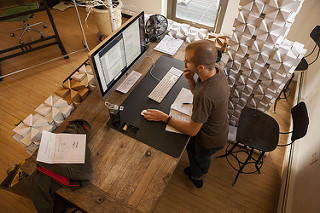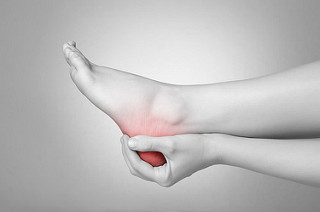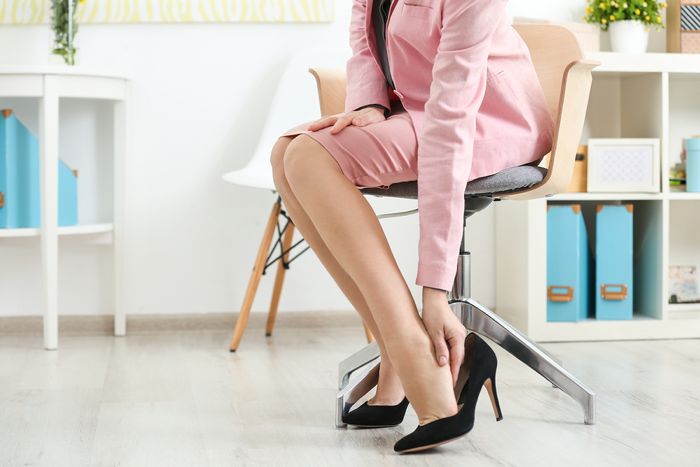Oh we thought we were so clever, didn’t we?
After we heard about all the health hazards associated with sitting at the computer so much (read more about those here), many of us switched to standing desks. Some of us bought new ones to fit into our writing spaces, and some of us made our own.
Whatever route we took, we couldn’t help but feel proud that we were doing something positive for our health and well-being.
After about a year of doing at least half of my writing standing up, I can say that it’s a definite improvement. Standing is easier on my back, and allows me to move more throughout the day.
I’m one of those that opted for creating my own setup. I use an old file box on which to place my keyboard, and thus can easily switch from sitting to standing and back again. I’ve determined that mixing it up is the best approach, as it keeps me moving and shifting, which is optimal for the body, and for burning calories. (Read more about how to set up the best, pain-free writing space.)
But recently I’ve experienced a disappointing development that I’m guessing other standing writers may be experiencing, too. Particularly if you write for a lot of hours each day like I do, you’re likely to find that standing for many of those hours puts you at risk for a new ailment: heel pain. Ouch!
Here’s more about this new writing malady, and how to prevent it and treat it.
 Standing Desks Create Their Own Risks
Standing Desks Create Their Own Risks
“I started standing at work about a month or so ago,” says a member on the Mark’s Daily Apple forum. “At first, it was only for a couple hours a day, but now I’m up to about six or seven hours a day. After standing in one spot for a while my heels start to hurt, and after a whole day, they’re killing me. Does anyone else have this problem?”
“Maybe two weeks ago I noticed that my heels have grown sore while using my standing desk,” writes another forum member on Reddit. “I feel the pain at the sole of my foot, directly below my ankle or perhaps slightly behind. Has anyone experienced anything similar?”
I find similar messages on other sites. As more and more people are getting out of the chair to work, more are experiencing the problems associated with standing.
There’s no doubt that standing for at least part of the day provides a number of health benefits over sitting. It increases energy and focus, helps improve circulation, prevents harmful buildup of fats and sugar in the blood, and helps you burn more calories than sitting.
In a 2011 study by the Centers for Disease Control and Prevention (CDC), researchers found that when workers used standing desks to decrease their sitting time by an hour a day, they reduced upper back and neck pain and improved their overall mood.
Scientists also believe that reducing the amount of time we spend sitting can help reduce our risk of heart disease, diabetes, obesity, and cancer.
But just like we’re not meant to sit for hours and hours without moving, neither are we meant to stand for hours. If we do so, we typically trade one set of painful conditions for another. Whereas sitting writers typically complain of upper back pain, neck pain, and shoulder pain, standing writers suffer more from leg and foot pain.
“In my own practice,” says Doug Richie Jr., DPM FACFAS, “I have seen increasing numbers of patients presenting with foot conditions that started when they switched to a stand up work desk. This is not surprising.”
So what’s going on?
 Why Standing Desks Create Heel Pain
Why Standing Desks Create Heel Pain
If you stand for long periods of time, particularly in unprotected feet on hard surfaces, the heels can get sore and fatigued. A hard floor doesn’t allow typical small movements of the feet and ankles, sort of “locking” them in place. That results in poor circulation through the foot, and can create inflammation that causes weariness, pain, and soft tissue damage.
All the time you’re standing, the foot muscles are working to keep you balanced and supported. Without movement, the same muscles have to continue working on a consistent basis, resulting in fatigue and inflammation. There is also consistent pressure on one area—often on the heels because they tend to absorb the majority of your weight.
Walking is typically less painful than standing because the activity allows the foot to move, and varies the pressure along the entire surface of the foot. Standing, however, doesn’t provide that same variation.
When we stand, according to Dr. Richie, “the intrinsic muscles of the feet are inactive and the dynamic mechanisms that stabilize the arch…do not engage. Therefore, the arch of the foot is stabilized only by static mechanisms, primarily the plantar fascia and the plantar ligaments. Strain in these structures is inevitable during prolonged quiet standing.”
That can result in not only pain and soreness, but other problems like plantar fasciitis, which is a strain on the tendon at the bottom of the foot that causes heel pain.
 7 Ways Standing Writers Can Prevent Heel Pain
7 Ways Standing Writers Can Prevent Heel Pain
Fortunately, there are things you can do to take the pressure off your feet and help prevent heel pain. They are listed below, and if you’re standing more than a half-hour a day while working, I highly recommend you invest in some of these steps to protect not only your heels, but your feet, legs, and joints in general.
In a future article, I’ll go into some of the other health risks that can come from standing too long. Indeed, as more writers and other desk jockeys adopt the standing position, they’re finding that it’s not the panacea they thought it would be.
Standing comes with it’s own set of problems, including an increased risk of circulatory issues (like vein problems in the legs) and knee pain. Some doctors like Dr. Richie are getting involved in getting the word out, so that people can take better care of themselves.
In the meantime, to protect your heels:
1. Give yourself time to adjust to the habit.
Many people get a standing desk and then switch from sitting all day to standing all day. This isn’t a good idea simply because you’re body isn’t used to it. Standing requires strength in different muscles, and it takes time to build them up.
Go gradual—start by standing for 30 minutes to one hour a day for about a week, and then slowly increase your time as your body adapts.
2. Mix it up.
Doctors today strongly advise against standing all day, just like they recommend you don’t sit all day. Instead, switch between the two. Stand for awhile, and then sit for awhile.
“Frequent transitions between sitting and standing [and vice versa] are likely to be more sustainable than five hours straight standing,” says Dr. Dunstan, head of physical activity at Baker IDI Heart and Diabetes Institute.
Vary up your positions as often as you can to allow movement in your muscles and to help improve circulation. Walk around in between each change in position.
3. Move more.
The problem with both sitting and standing is staying in the same position for an extended amount of time without giving your body a break. You need to move to relieve pressure points and get the fluids moving in your body.
So shift your weight from one foot to the other, sway back and forth, change positions with your feet (wider and then closer together), and shift from the balls of your feet to the heels and back. Resist locking your knees.
The best thing about standing is that you can more easily move while your work, so take advantage of it.
4. Check your posture.
Poor posture while sitting can cause back, neck, and shoulder pain. Poor posture while standing can also cause lower back pain, as well as knee pain and hip pain.
Make sure your computer or monitor is at eye level, tilted up just a bit, and that your computer is such that your arms are at a 90-degree angle. Don’t slouch, and use your core muscles to support your back. Keep your feet at least shoulder-width apart, your rib cage above your hips (so you’re not leaning too far forward or backward), and pull your shoulders back.
5. Get an anti-fatigue mat.
Professionals like hair stylists and chefs use these to help take pressure off the feet. They add cushioning to any floor (even if you have carpeted floor, it’s likely too hard for prolonged standing), and because they keep you just slightly off-balance, they require your feet to make tiny micro-adjustments to keep you balanced, which helps reduce pressure points and increase blood circulation.
The Sublime Imprint Anti-Fatigue Mat was tested by the Center for Ergonomics at the University of Michigan and found to reduce fatigue by up to 60 percent. There are many other options as well, but try to find a quality mat to enjoy the full benefits. This is about your health and well being, so it’s worth the investment.
6. Wear supportive shoes.
If you’re writing at home, you’re likely to be going barefoot, or writing in your socks and/or slippers. It may seem comfortable at first, but as I discovered, it’s not a good idea if you’re going to be standing for an hour or more.
Instead, wear supportive shoes when at your standing desk. As far as which ones will work best for you, that depends on your feet and what you need. Some may require running shoes with supportive arches, while others feel best in shoes that provide more cushioning.
If you’re experiencing heel pain, you may want to look into brands like Vionic or Naot that are made specifically to properly support the heels. If you have high arches or other sorts of arch pain, you may want to wear shoes with insoles that will provide more support.
7. Stretch at the end of the day.
Standing for hours taxes foot and leg muscles, tightening and shortening them over time. If you stretch at the end of each day, you’ll increase your endurance and significantly reduce your risk of pain.
Here are some helpful options:
- Tennis ball roll: Keep a tennis ball nearby and use it to roll your foot over, back and forth, for about five minutes on each foot. You can also roll it in circles. It provides a sort of massage for the bottom of your feet, increasing circulation and easing muscle and tendon pain.
- Toe presses: While standing, bend one knee, lifting the ankle off the floor while keeping the toes pressed firmly to the ground. The more you bend your knee, the more you’ll feel the stretch in those toes. Hold for 10-20 seconds and repeat on the other side.
- Ankle pumps and rolls: Lay down with your toes pointed toward the ceiling. Then point them forward, then back toward your head, then forward again, alternately stretching the calf and the front of your leg. After ten repetitions, roll the ankle in circles clockwise, then counterclockwise, about 5 times each. Repeat with the other ankle.
- Towel stretch: Sit on the floor with your legs straight out in front of you. Place a towel around your toes and gently pull it toward you while keeping the legs straight. Hold for 15-30 seconds and repeat twice. You should feel the stretch in your feet and calves.
- Marble catch: Set about 5-10 marbles on the floor, and practice picking the up and moving them with your feet. Use your toes to grip and release. This exercise helps strengthen the metatarsal arch so it can support you when standing.
- Step stretch: Stand on a step with your heels hanging off the edge. Slowly lower the heels until you feel the stretch in your calves, hold for 10-20 seconds, and raise them up level again. Repeat 3 times.
- Toe stretch: Sit down and cross one leg over the other. Grab your toes with one hand and gently pull them toward you, then release. Hold each pull for about 30 seconds.
Have you suffered from heel pain after using a standing desk?
Photo credit standing desk: juhansonin Studio Desks: Eric Benoit via photopin
Photo credit heel pain: gm.esthermax Best Work Boots for Plantar Fasciitis for Men via photopin
Sources
Gwynn Guilford, “There’s a huge hidden downside to standing desks that no one told me about,” QZ.com, September 29, 2014, https://qz.com/272350/theres-a-huge-hidden-downside-to-standing-desks-that-no-one-told-me-about-2/.
Doug Richie Jr., “Taking a Stand Against Stand-Up Working Stations,” Podiatry Today, March 30, 2016, http://www.podiatrytoday.com/blogged/taking-stand-against-stand-workstations.
Nicolaas P. Pronk, et al., “Reducing Occupational Sitting Time and Improving Worker Health: The Take-a-Stand Project 2011,” Preventing Chronic Disease, October 11, 2012, 9:110323, https://www.cdc.gov/pcd/issues/2012/11_0323.htm?s_cid=pcd9e154_x.
Sydney Trent, “Standing up at your desk may energize you, but it may also be tough on your legs,” Washington Post, November 25, 2013, https://www.washingtonpost.com/national/health-science/standing-up-at-your-desk-may-energize-you-but-it-also-may-be-tough-on-your-legs/2013/11/22/4d166d9a-0f46-11e3-8cdd-bcdc09410972_story.html?utm_term=.421a4d01f19c.
Stephany Aulenback, “6 Ways to Fight Fatigue While Using Your Standing Desk,” Desk Hacks, 2013, http://deskhacks.com/reduce-standing-desk-fatigue/.


For the last couple of years, my husband and I have been using standing desks–the programmable electronic ones. Neither of us have experience any pain and I think it’s because we’ve always use the anti-fatigue mats. He also wears tennis shoes on top of that. It just felt like common sense to use these mats if we’re going to be standing and working for long periods. Like you said, they are worth the investment. (We got ours from Bed Bath & Beyond for less that $100 each.) Lots of great info, Colleen!
Anti-fatigue mats it is! Thanks for sharing, April. Great to hear from those using these things daily. :O)